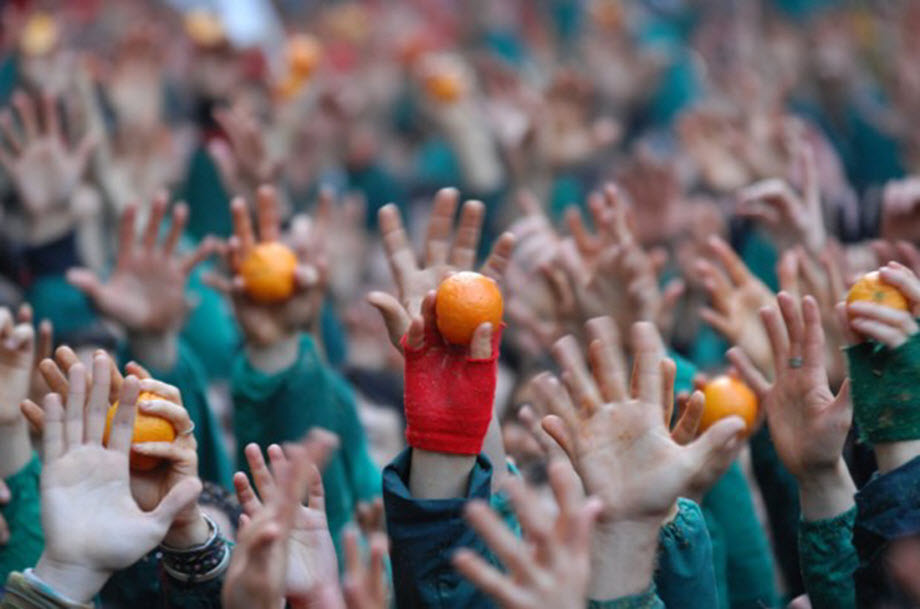The Battle of the Oranges is possibly the biggest organised food fight in Italy (not the world, Spain’s La Tomatina beats it in scale). For three days every year in February, this bizarre festival is held in the Northern Italian Piedmontese city of Ivrea.
The battle of the oranges celebration takes place over three days in February, the Sunday, Monday and Tuesday before Ash Wednesday.
The townsfolk of Ivrea divide up into 9 squads, dressed in their finest battle going attire, take to the streets of Ivrea and instead of using traditional weapons to attack each other, throw oranges instead.
All attempting to eliminate the other teams. These orangey battles begin on Sunday, Monday and Tuesday at 2:30pm.
Whilst the origins of the Battle of the Oranges remains unclear, it is known that it loosely reenacts the civil war that broke out between the people of Ivrea and the Royal Napoleonic Troops.
According to the people who take part, the events that the festival portray are the results that followed the beheading of an evil marquis, by the girl he attempted to rape.
In the aftermath of his death, the townspeople stormed his palace in revolt. It is this revolt, which is symbolised by the Battle of the Oranges every year.
To maintain an element of truth about the festival, every year a young woman is chosen to represent the original unfortunate woman.
The battle is made up of squads of aranceri or orange throwers on foot (representing the people) and defending their piazzas from those throwing the oranges (that represent arrows) from carts (representing the Napoleonic troops).
At the end of the three days, one of the chosen generals (whose duty it is to guarantee the correct proceedings of the event) will officially end the ‘war’ and on Mardi Gras itself, a huge funeral is held.
Also participating in the festivities are the customary Napoleonic General Staff, composed of mounted officers and Vivandieres.
Completing the line up are a vast array of historic personalities and traditional figures, including the Assistant Grand Chancellor, the Magnifico Podestà (or guarantor of the city’s freedom), and the Parade of Parish Flags.
Essentially the carnival brings the city together, fills it with bright colours and fresh citrus aromas.
There are more than 40 decorated horse drawn carts that each carry 12 throwers (who represent the castle) through the 5 piazzas of the city where over 3,500 rebellious warriors, represented in 9 teams, attempt to overwhelm them with their vicious orange throwing techniques.
Although the orange throwers on the wagons are protected by formidable gear, they are vastly outnumbered.
During the three days, over 500,000 pounds of imported Sicilian oranges will be thrown and destroyed. And just like in any battle, there will be casualties (mainly cuts and bruises) and luckily for them there are official observers during the festival, who award prizes for bravery and accuracy.
The winning team is determined by a jury who takes into account the decorations of the piazza (each team gets a half of a piazza to decorate) and the fury and accuracy of the team’s orange throwing talents.
Before the battle on the Sunday, the participants are fed with free beans – perhaps to sustain them during the rigours of battle, perhaps as a throw back to when the townsfolk were so poor the feudal lord used to give out beans to the poor, to nourish them.
The signal for the start of the festival is the holding up high of a child by each of the 4 quarters of the town.
Events draw to a close with the final burning of the scarli (which are large wooden poles) and a codfish and polenta feast in the Borghetto area of the city.
The population of the town (25,000 residents) quadruples for the event and it’s impossible to drive through the streets as most of them are closed for traffic control or to allow the carts to pass through.
Most hotels are booked a month in advance, but a night’s stay is really not necessary to witness the battles.
If you would like to stay but hotels in Ivrea are full, try hotels in Turin, the nearest big city about 50kms away.
Attend the event at your own risk – you’ll notice the ‘palace guards’ don protective clothing that looks like ancient armour (it’s not just for aesthetics).
Technically, you’re supposed to be a member of a team if you want to participate in the battle, and foreigners are usually accepted if they pay a fee.
More cautious spectators can view the proceedings from a safer perch, behind the nets that are draped around buildings.
All observers are encouraged to purchase and wear the Berretto Frigio or Phrygian Cap – a red hat that marks you as one of the revolutionaries.
The cap should also protect against any fruit intentionally being thrown your way. Regardless of what role you play, be sure to wear non-slip shoes – a slippery sea of squashed citrus does not make for sure-footing.
Whilst the battle of the oranges is the obvious highlight of the Carnevale di Ivrea, it’s not the only activity to enjoy during the festival.
Don’t leave without trying the fagiolate, the beans that the participants are fed before they battle. It is a delicacy of beans and cured pork.
Wash the meal down with vin brulé, the local spiced wine, served hot.

